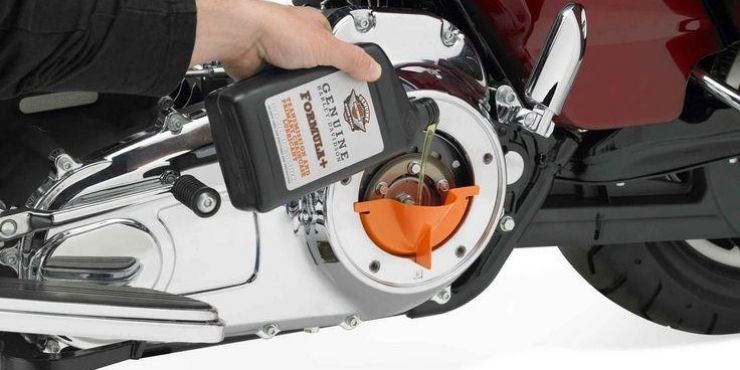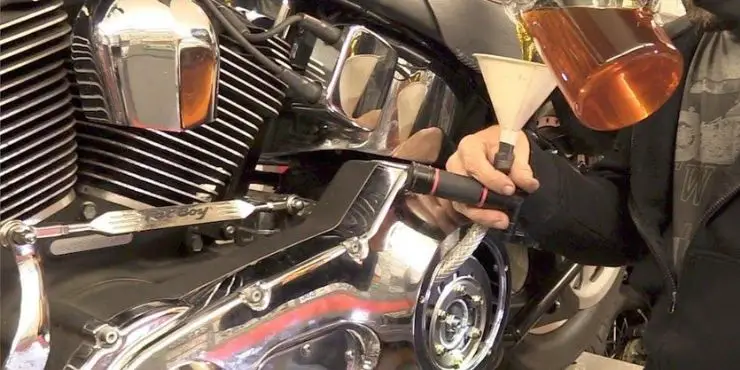Do you have a refill date coming up, and you’re busy finding answers to how much oil should go in a Harley primary? If yes, then you don’t need to worry anymore. You will find all the answers here.
A Harley-Davidson primary generally takes about 1 quart (32 ounces) of oil, but you should refer to your owner’s manual for the exact amount specific to your model.
In this article, you will get to know all primary oil, how much oil goes in a Harley primary, the important considerations, and a lot more. Continue reading to know more.
How much oil goes in a Harley primary
If you’re looking for answers to how much oil goes in a Harley primary, the answer is simple – one quart. You will need to fill one quart of primary fluid in the primary of your Harley-Davidson motorcycle. However, ensure that you check the owner’s manual of the bike to know the accurate primary capacity in your bike. Make sure that you don’t overfill the reservoir. After that, take your Harley-Davidson bike on a short ride for bringing the engine to operating temperature.
The primary should always be filled up to the bottom of the clutch spring. It is recommended that you should start with one quart. Then, add more oil little by little until the level has reached the bottom of the shiny ring present at the bottom of the clutch housing. There are many choices that you can go for when buying primary oil. The best option would be Mobil 1 Racing 4T 10W-40 motorcycle oil , but you can also go for Mobil 1 V-Twin 20W-50.
You must keep in mind that you shouldn’t add too much primary oil to the bike. Adding too much oil will increase the pressure on the crankcase. This will force oil out of the components and into the intake system. This can easily cause damage to the engine while also burning oil in the engine. Ultimately, this will cause a great deal of damage to the components in the bike.
What viscosity of primary oil should be used?
On the typical shelf, you’ll find many straight-weight oils like SAE 50, but there will be many multi-viscosity oil options. 20W-50 and 10W-40 are two of the most common types of primary oils used in Harley-Davidson motorcycles. Lacking an in-depth breakdown, viscosity can be thought of as the resistance to pouring. When you see an oil product described as 20W-50, the first number will be the viscosity at 0° F.
Meanwhile, the second number will be the weight of the oil at 212° F. The “W” actually stands for “winter”, describing the oil’s cold-weather characteristics. The higher the numbers go on the oil, the more resistant they’ll be to flowing.
Generally, oil is thinner and less viscous at higher temperatures while it is thicker and more viscous at lower temperatures. A multi-grade oil will come with the characteristics of both types. For instance, a 10-30W oil option will behave like a thin oil when cold, but it’ll act like a thick SAE 30 oil when hot. These types of oils come with long-chain molecules that are added to them. They allow the oil to be much more resistant to flow when the engine is running at operating temperature.
Multi-grade oils will offer the thicker viscosity benefits of higher grad straight-weight oil at higher temperatures. Moreover, they will also help reduce the friction from oil at lower temperatures. This reduces the frictional force from the engine when starting while ensuring sufficient film thickness at high temperatures.
The bike’s manufacturer will recommend a viscosity based on the motorcycle’s operating temperature. You must follow these guidelines. If you’re planning on switching things around, you should keep a few things in mind. While some Harley-Davidson bikes operate under a huge range of ambient temperatures, most bikes are used exclusively in warmer weather. Generally, multi-weight oils are better for operating bikes in dynamic conditions. However, not all types of bikes will see a variance in ambient temperatures.
Some Harley-Davidson models in the market come with an electric start. This means they’re not receiving the prime kicks that get the oil circulating before the engine has fired up. In such instances, a thinner oil will be helpful in the critical few seconds when it isn’t being dry-started. This is the brief period of time the engine runs after starting, but before the oil starts flowing.
Thirdly, primary oil will serve as the coolant on air-cooled bikes. It’ll be subject to a wider range of operating temperatures than liquid-cooled machines. Additionally, this will mean that some of the operating clearances will be wider. It means that two engines having the same cylinder configuration and displacement could have different oil viscosity requirements if one is liquid-cooled and one is air-cooled.
Important considerations when choosing the primary oil
If you have an oil refill appointment on the horizon, you’ll need to know which primary oil option to consider. Choosing the wrong option might end up damaging the bike. This is why you must follow these important considerations to choose the primary oil.
Additives
Oil manufacturers have made it a norm to add additives into the oils. This way, they can market the oils as a great way of removing debris and neutralizing acidity. These oils will help in keeping the temperature cool while lubricating the components. Moreover, these will also clean the carbon formations collected on the parts. The oil will then act as a natural cleaner, helping avoid ripping apart the components to clean them internally.
Primary oil grades
You’d have seen oil cans printed with a bunch of numbers and letters like 20W-50, 10W-40, and so on. Even though the common misconception is that the numbers are temperature indicators, they are not actual temperatures.
The “W” will stand for winter, while the number before it would be the viscosity index. The lower the number is, the better will be the oil for engines required to have a cold start. The number after the “W” is an indication for the oil to withstand its properties. The higher the number, the better will be the oil at staying consistent at high temperatures. The viscosity numbers are relative and will hold no actual value.
Compliances
Most countries in the world come with a compliance standard that oil manufacturers need to adhere to. Some examples are Society of Automotive Engineers (SAE), Japanese Engine Oil Standard Implementation Panel (JASO), American Petroleum Institute (API), etc. These will set the standard for engine oils and ensure that they meet the original equipment manufacturer’s requirements. These standards help the users know about the stringent qualities maintained in the oil’s performance in the bike. Moreover, the user will be able to put their trust in the oil options.
Viscosity
Viscosity is essentially an index that suggests the state of being sticky, thick, and semi-fluid inconsistency. A lower viscosity oil flows faster and freer and will be suitable for the lubrication of high-performing machines. Mineral oils usually come with a higher viscosity as compared to synthetic oils. If you choose an oil with the wrong viscosity, it might cause the metal to grind on metal in the engine. Ultimately, you will lose out on efficiency.

Riding style and purpose
If you use your Harley-Davidson bike for a normal everyday commute, miner oils could be the better option. They’ll be comparatively less expensive and give proper care to your bike. Some people prefer using semi-synthetic oils after driving a few thousand miles. If you love long drives and journeys in tough terrains and conditions, then synthetic oils would be a perfect choice. Synthetic oils will come with less viscosity, efficiency-boosting capabilities, and offer better peak performance.
Manufacturer recommendation
All manufacturers have their respective recommended primary oil options for their motorcycle models. This will be based on the motorcycle’s components and type. It would be smart to adhere to the recommended grade of the oil suggested by the manufacturer. This is the case because the manufacturers have already made the necessary considerations of the bike and its capabilities.
On average, Harley-Davidson riders believe that they must stick with the recommended primary oil option for at least six changes. Then, you can easily flush the oil and use the option that best suits your motorcycle’s needs. This will depend on how far you ride and how frequently you ride.
Important tips to remember when filling primary oil in Harley-Davidson bikes
- You can easily check the primary oil levels using light and your eyes. Ideally, the oil needs to be touching the clutch diaphragm and not flowing out. Check the primary oil and regular intervals and refill it if needed. Whenever you’re adding or replacing the primary oil, make sure to clean the components, as it’ll help with better performance.
- Make sure that you’re running the bike for a couple of minutes before you drain out the primary oil. When you’re draining out or adding new oil, remember to wear the necessary safety gear and use the proper tools. This will help you ensure that filling the primary oil is as clean and straightforward as possible. Moreover, once you’ve drained the oil, you need to refill the primary oil with the manufacturers’ recommended quantity in mind.
- Make sure that you stick to the manufacturer’s recommended service timing intervals. Generally, for Harley-Davidson bikes that require primary oil, the oil must be changed every 10,000 miles on average.
- Always install a new, primary oil drain plug once you remove the old drain plug. Further, it would be even better if you change the primary oil case gasket each time that you’re changing the primary oil.
- Avoid using automotive oils as they come with friction modifiers to help the car’s idle smoother. This can easily result in harming your Harley-Davidson bike’s transmission and might even cause a slipping clutch.
- Read the reviews of all the oil options you’re considering. Reading the reviews and comments will help you get a better idea of what you can expect from the oil.
Conclusion
Thank you for reading. Hopefully, now you know much more about how much oil goes in a Harley primary and other aspects of it. Normally, you will need to fill about one quart of primary fluid in your Harley-Davidson motorcycle. However, be sure that you check the owner’s manual before adding primary oil. It will let you know the exact amount to be added and the primary capacity of your bike. The two best options for primary oil are Mobil 1 Racing 4T 10W-40 and Mobil 1 V-Twin 20W-50.

